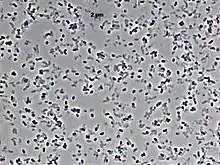Vibrio anguillarum
Vibrio anguillarum is a Gram-negative bacteria that is pathogenic to a variety of fish, crustaceans and bivalves which collectively amount to more than 90 susceptible aquatic organisms in at least 28 different countries. Septicemic host infection with V. anguillarum is known as vibriosis and causes symptoms such as internal and external ulceration, abdominal distension, petechia, flesh rot, lethargy, appetite loss, necrosis, erythema, sheathing of arteries and circulatory haemorrhage, boil formation upon muscle tissue, visual lesions and eventually death.
| Vibrio anguillarum | |
|---|---|
 | |
| Scientific classification | |
| Domain: | |
| Phylum: | |
| Class: | |
| Order: | |
| Family: | |
| Genus: | Pacini 1854 |
| Species: | Vibrio anguillarum |
Studies by Nybelin (1935) and Smith (1961) collectively categorized V. anguillarum under three biotypes: (i) type A being able to produce acid from sucrose or mannitol without gaseous by-product, as well as producing indole, (ii) type B being unable to react with sucrose or mannitol to produce gaseous by-product or indole and (iii) type C being able to produce acid from sucrose and mannitol but not gaseous by-product or indole.
Growth Conditions
V. anguillarum is a [[Gram-negative],arcuate-rod bacterium with one polar flagella. The pathogen grows between 30 and 34°C, although recommended by ATCC to be cultivated at 26°C. The bacterium is sensitive to pH changes, with an optimum pH of 7, inhibited entirely over pH 9, and significantly disrupted at pH6 or below (Gilmour et al. 1976; Larsen 1984).